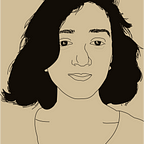Am I solving the right problem?
Drawing on a recent experience
As UX designers, we are constantly told that design is all about solving problems. While this philosophy seemed easy enough to implement during internships and client projects where I had a project brief, it posed a challenge when I embarked on an independent project.
I spent weeks looking for problems to solve. It probably sounds ridiculous out loud, considering we live in a world rife with pain points.
But this was different. I was beginning a personal UX project with limited research resources. So identifying the problem and the target market was like a chicken-and-egg situation.
To successfully know the target audience, I need to know what I’m creating, and I don’t know what to build unless I know whose problems I want to solve.
After being in this conundrum for a few days, I decided to take a closer look at people’s lives around me. And there it was — a problem, enclosed in shiny silver metal. So I decided to design a refrigerator inventory system.
Unfortunately, I buy various items to try new recipes but often forget about things at the back of the fridge. I wondered if other people underwent a similar situation. I imagined designing an app to keep track of expiry dates through barcode scanning.
I set up a few user interviews to validate my hypothesis. However, the results were slightly unexpected.
While all of my research participants encountered the problem of forgetting and wasting food regularly, none of them wanted a solution!
My mistake in choosing a problem was not taking into account the culture around something so personal as food. While meal-planning and waste management apps are all the rage in some other countries, I hadn’t considered the relationship of Indians with groceries. Although supermarkets are popular, a large percentage of fresh produce is purchased from roadside vendors that sell local, fresh produce by weight. No barcodes, no labels.
Additionally, I hadn’t considered the amount of effort required on the user’s part to update these quantities in their “virtual refrigerator” regularly. Getting a push notification every time the veggies are going bad sounds fantastic, sure. But wouldn’t it be far easier just to scan the contents of the refrigerator daily?
One of my research participants spoke about her system of keeping a box in the refrigerator for all the close-to-expiry items, resulting in a visual cue to use them at the earliest.
After my initial research, I was somewhat downcast, thinking my ideas weren’t good enough. But looking back, I realise that design is all about the “fit”.
Does this problem need a solution here and now?
Does my solution seamlessly fit into the lives of the people I’m solving for?
Keeping these questions in mind, I decided to choose a problem with an effective one-way solution. Apps that do not require a lot of effort on the user’s part.
Hailing from a family of doctors, I often hear about the declining quality of lifestyles since the onset of the pandemic.
I’m currently working on a solution that is conducive to healthy habit-formation.
I found that people like seeing results and knowing how the new activity will benefit them in the future. Thus, tangible benefits of a particular action are vital motivating factors.
For instance — one participant wants to meditate more often to deal with stress daily.
Another wanted to be stronger through exercise since sitting at a computer all day gave her a perpetual backache.
While there are several habit-tracking apps on the market, they all require a relatively high amount of effort in terms of logging daily information. This time around, my research conveyed a need — a need for something simpler.
Building healthy habits is hard enough. How might I make it easier?
To sum up my learnings:
- First, focus on finding problems whose solution is likely to create value.
- Second, be more aware of your surroundings. Actively listen to people talk about their habits, frustrations and goals.
- Finally, don’t be fixated on a project or idea before doing any user research.
